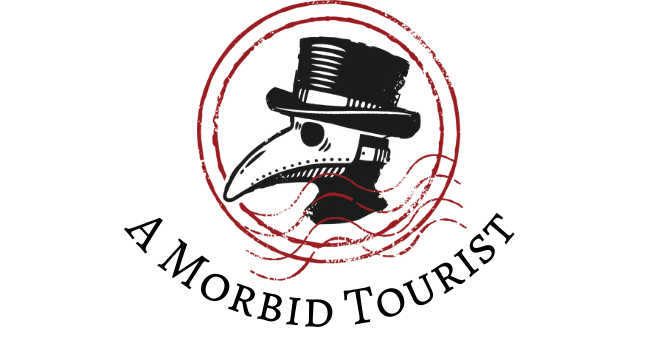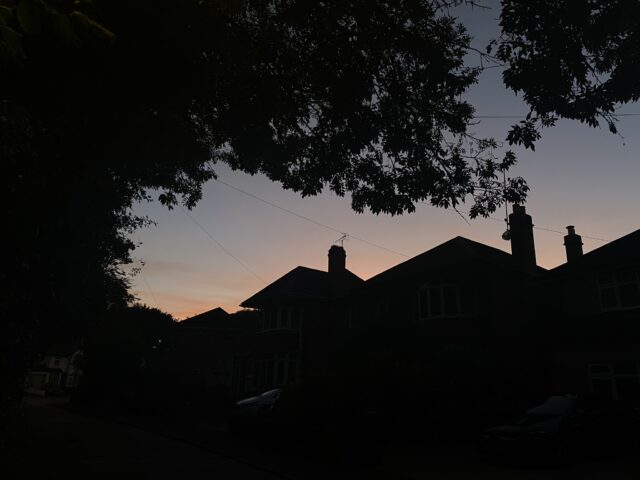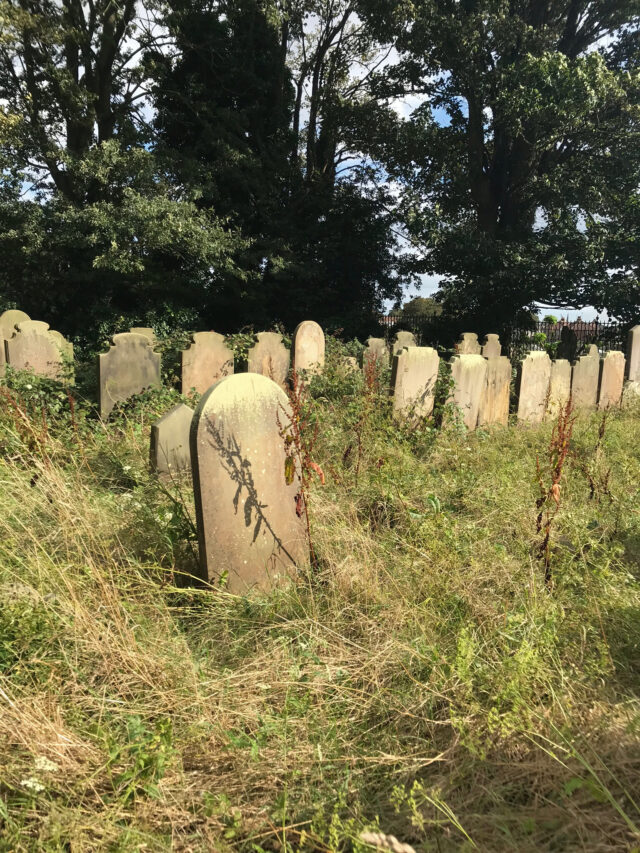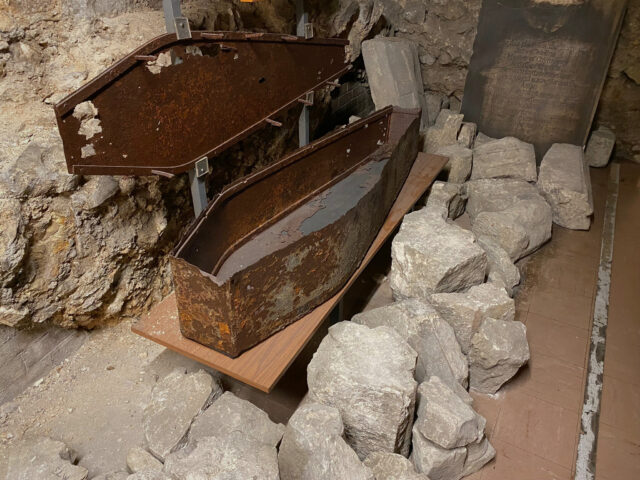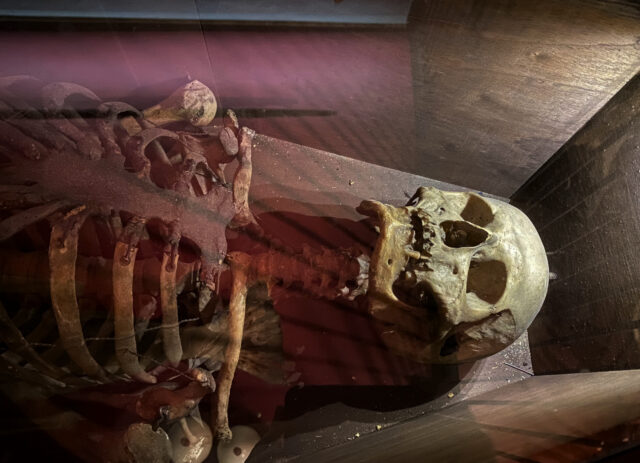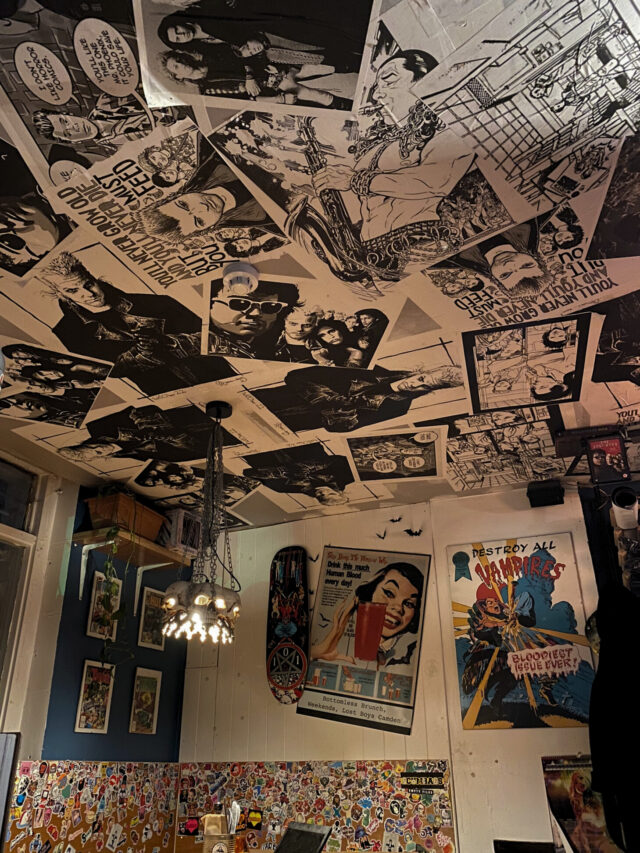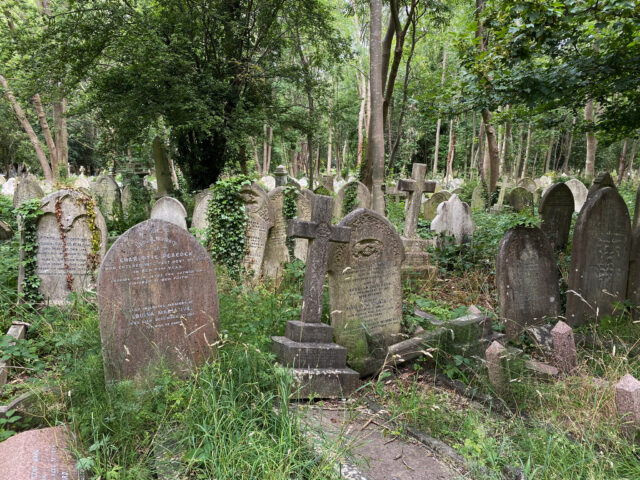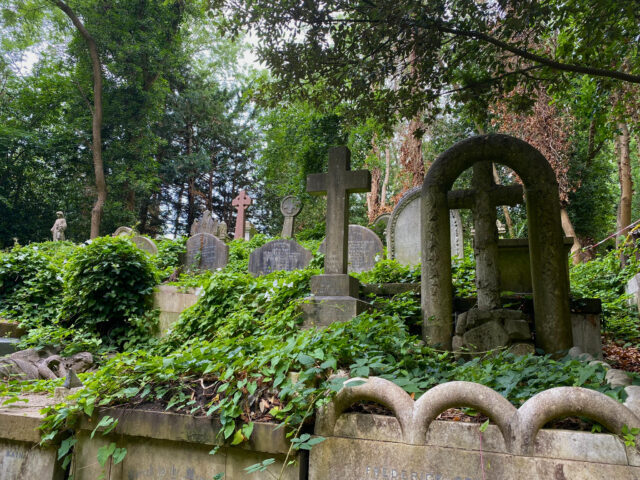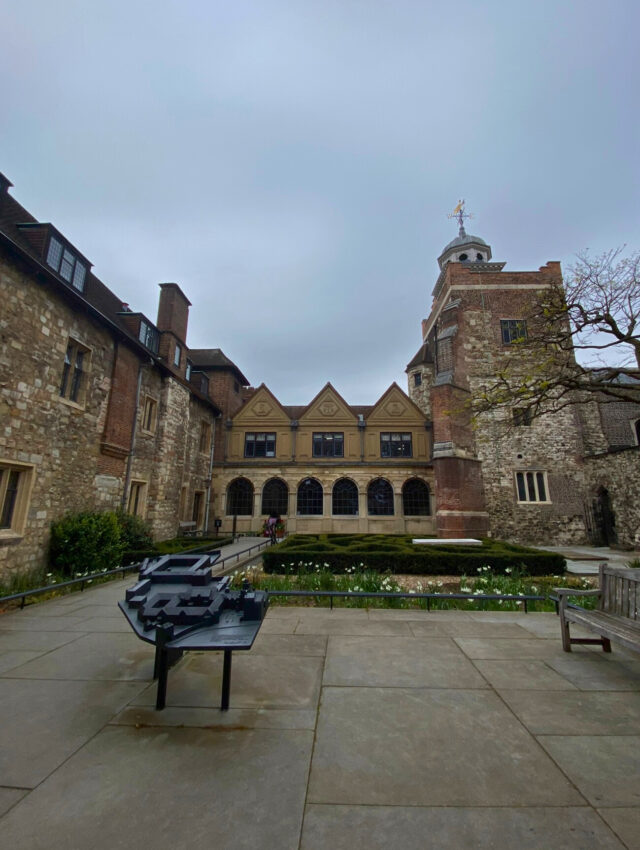The Charterhouse
and its Plague Skeleton
I’ll be honest with you – I originally only went to the Charterhouse for the skeleton.
Let me explain. The Charterhouse as a building began its life in 1371 and was a monastery. However, before any structure stood there, the area was used as a plague pit. During the Black Death, which began in 1348, London was overwhelmed with the dead and churchyards filled up fast. The solution was to dig enormous pits to inter piles of corpses all at once.
“In this plot of ground there were in that year, 1349, more than fifty thousand persons buried.” – John Stow, 1598
One of these pits was established in what is now Charterhouse Square, and it was upon this ghoulish site that The Charterhouse was built.

With that kind of morbid history, I was already curious. And upon reading that they had a real plague skeleton on display there, I was sold.
The Square
The Charterhouse sits in Charterhouse Square (surprisingly), a short walk away from the Barbican underground station. Barbican is closest but you can also walk from Farringdon, if that’s easier to travel to. The square is a tucked-away piece of quietness in the bustle of the nearby City, and I noticed the peace as soon as I passed through its gates.

Like most London squares, Charterhouse has a lovely green space in its centre. The main tarmac road gives way to cobbles when you head over to the Charterhouse campus.
A Colourful History
I learned that the Charterhouse has had many lives, aside from the plague history I already knew about. It’s been a medieval monastery, a Tudor mansion (visited by Queen Elizabeth I herself!), a boys’ school, and an almshouse.
During the Black Death, a courtier and soldier named Walter Manny established the first building on the Charterhouse site. Sir Walter, like many Christians of the time, believed that the pestilence was a punishment from God for society’s sins. In order to stop the plague, a small chapel was built upon the plague pit, so that people could pray for an end to the sickness.
In 1371, this chapel became a Carthusian monastery and was officially named The House of the Salutation of the Mother of God.

© The Charterhouse
Tudor Times
Monasteries didn’t fare well under the rule of Henry VIII. After the Church of England was set up, our boy Harry wanted to remove as much Papal influence as he could (as well as nicking the assets, of course). Thus, most of the monasteries in England were decimated.
The monastery at Charterhouse Square was no exception. Once the dissolution was done, it was left in ruins. The Prior, John Houghton, was the first martyr at the infamous Tyburn ‘tree’ (yes, that’s a euphemism for gallows).
1540 saw the building of a splendid Tudor mansion on the site of the ruined monastery. The mansion still stands today, including the incredibly beautiful Great Hall.
Sutton’s Charity
Thomas Sutton, a very wealthy ‘commoner’, purchased the Charterhouse complex in 1611. He established a charity that still runs today! On site, he created both a school and an almshouse.

In Sutton’s will, he left some of his fortune to the provision of care for up to 80 men, referred to as ‘Brothers’. These men had to be ‘either decrepit or old captaynes either at sea or at land, maimed or disabled soldiers, merchants fallen on hard times, those ruined by shipwreck or other calamity’. He also specified that 40 ‘poor boys’ should be given free schooling with his money.
The Foundation was governed by some big names at the time, with James I heading it up as Royal Governor. Some other governors included Francis Bacon, Oliver Cromwell, and Prime Minister William Gladstone.
Charterhouse School
The school that Sutton set up continued to grow, and became too big for the original campus at Charterhouse Square. It moved in 1872, and now lives in Goldalming, Surrey. On a 250 acre campus with incredible, beautiful buildings, the school is absolutely charming to look at. In 1971, they broke from the tradition of being boys-only and allowed girls into 6th form. Finally, in 2017, the school became completely mixed-sex.
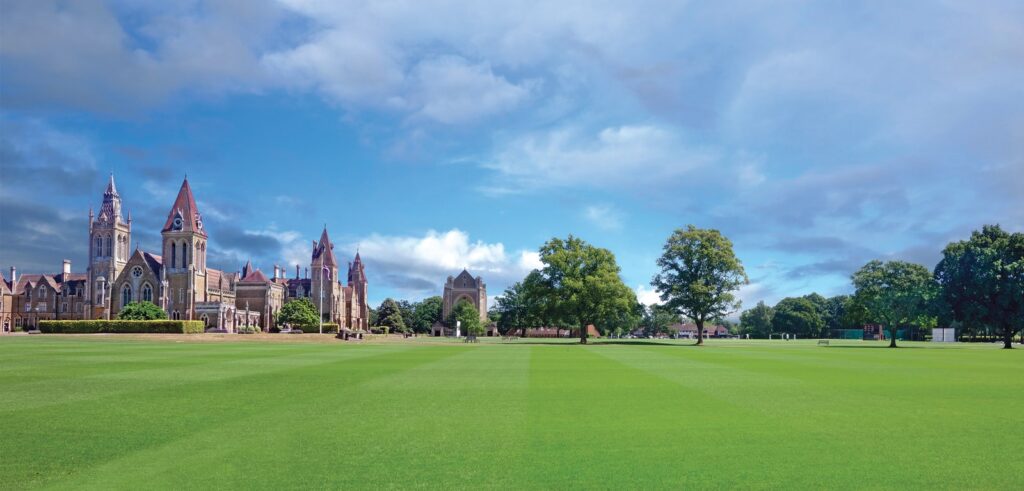
Ironically, the school originally dedicated to ‘poor boys’ is now one of the most expensive in Britain. We poors really can’t have anything. There are scholarships and a bursary, but these are only given out at the school’s discretion. I don’t know… I feel like this sort of spits in Mr Sutton’s face a bit.
As for the almshouse, the Brothers remained at the square and are still there today. I mean, the current residents of the almshouse, not the original guys (that would be terrifying).
An Enduring Reputation
Over the next few centuries, many people opted to be buried at the Charterhouse. I don’t blame them – it’s a beautiful, serene place to rest. The Charterhouse has also appeared in works by some amazing writers, including Daniel Defoe and Charles Dickens. She’s a bit of a celebrity!
I think I’m going to stop the history lesson there. It’s getting a bit long, and we haven’t even set foot inside yet! There is so much more to the Charterhouse’s story, so definitely go to their website to find out more (when you’re done reading this post, of course).
Sutton’s Greyhound
I really wanted to write a little about this. As I explored, I kept noticing greyhounds. Carved greyhounds at the ends of the chapel pews, items in the museum with a greyhound on them, greyhound-themed art. At the time, I didn’t know why.

The museum explained more: the greyhound was part of Sutton’s heraldic device. Because he was a ‘commoner’, he wasn’t allowed a coat of arms (classic English classism!) so the device was the next best thing. A major part of this crest was the greyhound – I’m unsure why. Maybe Sutton just liked them a lot? If you know this information, please tell me in the comments!
Greyhounds also became the main symbol of Thomas Sutton’s charity. I love all sight-hounds (my little brother has whippet and a saluki), so I think the greyhound is a lovely mascot!
The Chapel
Honestly, I didn’t spend enough time in the chapel, or take photos of everything I should have. Which is very annoying in hindsight!
The original Carthusian monastery that was built on the site of the Charterhouse no longer remains. One section of the east wall is all that’s left. The current chapel is newer, built at the same time as the Tudor mansion, and has been modified and added to ever since. Here’s a really interesting link to the chapel’s full history.
My favourite part was the enormous monument to Thomas Sutton. As he set up the charities at the Charterhouse, he’s held in high esteem. Sitting in the north aisle, this thing is gigantic and sumptuous. An alabaster carving of Sutton lies at the bottom behind a fence, in peaceful repose.

They also have, preserved in a box, a fragment of Walter Manny’s original, beautifully painted tomb. It’d be about 652 years old now (in 2024), but the paint is still so vibrant.
You can attend services at the chapel. It’s open to anyone, of any faith (or none). While I was wandering around in there, it was April and they had a cute Easter diorama set up, which I admired for a long while.

Charterhouse Museum
Immediately the museum appealed to me, because of the way it has been set out. There’s only one way to go through it, and you begin in the present day. Gradually, as you work your way along, you go back in time. It was a super interesting way to lay out the exhibition. It’s a small, almost S-shaped space, but it’s full of cool, fascinating things.
Later, I read that the collection is actually HUGE. I only saw but a glimpse of it. There are apparently 1000+ photos, paintings, and drawings alone. Current and former Brothers of the almshouse have also contributed their art and works, which I think is cute! Off-site, there are a few libraries worth of books and papers – the Old Library even contains a silver collection.

In the Tudor Great Hall, there are tapestries that were purchased in 1615 (RIDICULOUS!). These beauties luckily survived the Blitz. The Great Hall itself is the only surviving Tudor Great Chamber in all of London! It was damaged during the Second World War, but has been carefully restored and conserved.
A lot of the artefacts are privately kept in the residence where the Brothers live. However, the Charterhouse website says that they’re in the process of photographing and cataloguing these to share with the public. Yay!
It’s amazing how big the whole collection is, and I feel like an awful guest for not knowing about all this while I was there.
My Museum Highlights:
I never like to talk exhaustively about things like museums, as I feel like that’ll spoil it for anyone who wants to go. Having said that, I want to include my favourite bits.
I. A photo of Walter Manny’s (remember him?) coffin being opened in 1947. I suppose they wanted to see if he was buried with anything cool. Still a bit weird to just disinter the fella, though. It makes for a bloody macabre photo. This wouldn’t look too out of place in a horror film:
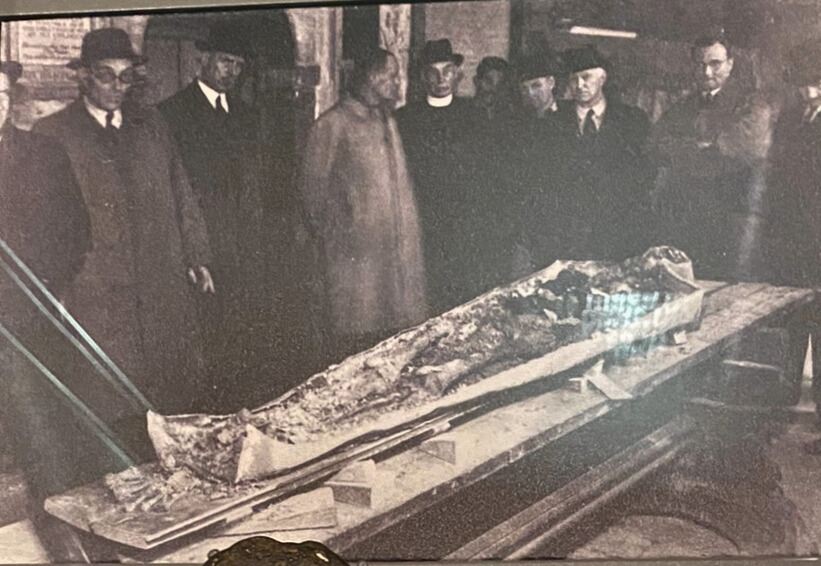
II. Staying on the coffin theme (naturally), I loved the plaster cast of Thomas Sutton’s coffin. Sutton’s body is buried in the Charterhouse chapel but, weirdly, his bowels were buried in Hackney church. NO idea why. Anyway, they opened ol’ Tom’s crypt and made a cast of his lead coffin. Only the top half survives today, and it’s that half that I saw in the museum.

III. Charterhouse School have donated several items to the museum. One that I absolutely loved was the ‘black book’. Basically a record of the schoolboys’ misdeeds, and the punishment doled out to them. Monitors – who were students themselves – were responsible for keeping the black book up to date and disciplining the other pupils. Yes, including corporal punishment.

Obviously, young lads being beaten up isn’t the thing I loved about the black book. It was reading about the various sins they got booked for that had me chuckling. Some of these include:
- Cheeking the Preacher in the chapel – lad had to do an extra hour of school and memorise a Bible passage (in Greek!!) to the satisfaction of his punishing Monitor. Tight.
- Coming into school in slippers – the culprit was fined a whole twopence for that bullshit!
- Slovenly dress – funny wording, but the unfortunate slovenly boy got a ‘swishing’ for this one (a swishing involved being beaten with a birch switch, sometimes to the point of real injury).
- Fighting with Neville on the Upper Green – this boy (and Neville) had to thoroughly clean the kitchen cellars
- Losing his Latin grammar book – whoever doled out this punishment is hilarious. A William Hay had to do an extra hour of school and write 100 lines. The line he was given: ‘The Roman empire is not to be forgotten’. Absolute bants!
VI. My final highlight is this little chocolate box, bearing the ubiquitous greyhound of Thomas Sutton. Just because it’s cute:
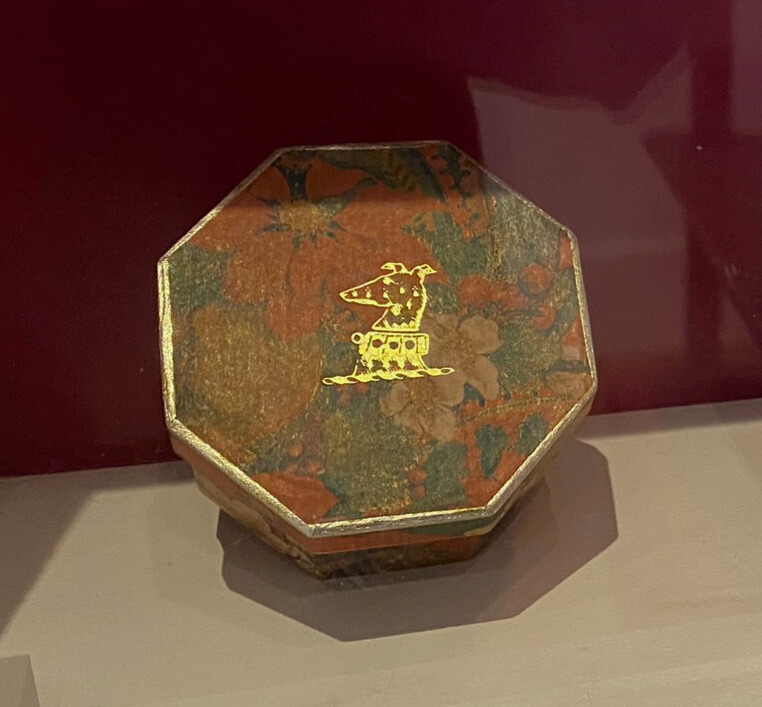
The Plague Skeleton
The museum display ended where the Charterhouse began, in the plague days. At the dead-end (heh) of the museum, the last exhibit is the plague skeleton, and the main reason I was there.
When he was alive, the Charterhouse plague skeleton was an unknown man between the ages of 18 and 25. Just a baby! Researchers learned a lot about him from analysing his bones. That he had been breastfed. That he ate mostly plant-based food, and that he was under nutritional health stress as a result. He had caries cavities and periodontal disease. Poor lad, but how cool is it that we can learn all of that through bones!?
Most importantly of all, though, they found the presence of Yersinia Pestis in the skeleton’s bones. I’ve mentioned this charming little bacteria before. This was the smoking gun that tells us for sure that the young man died from the plague.
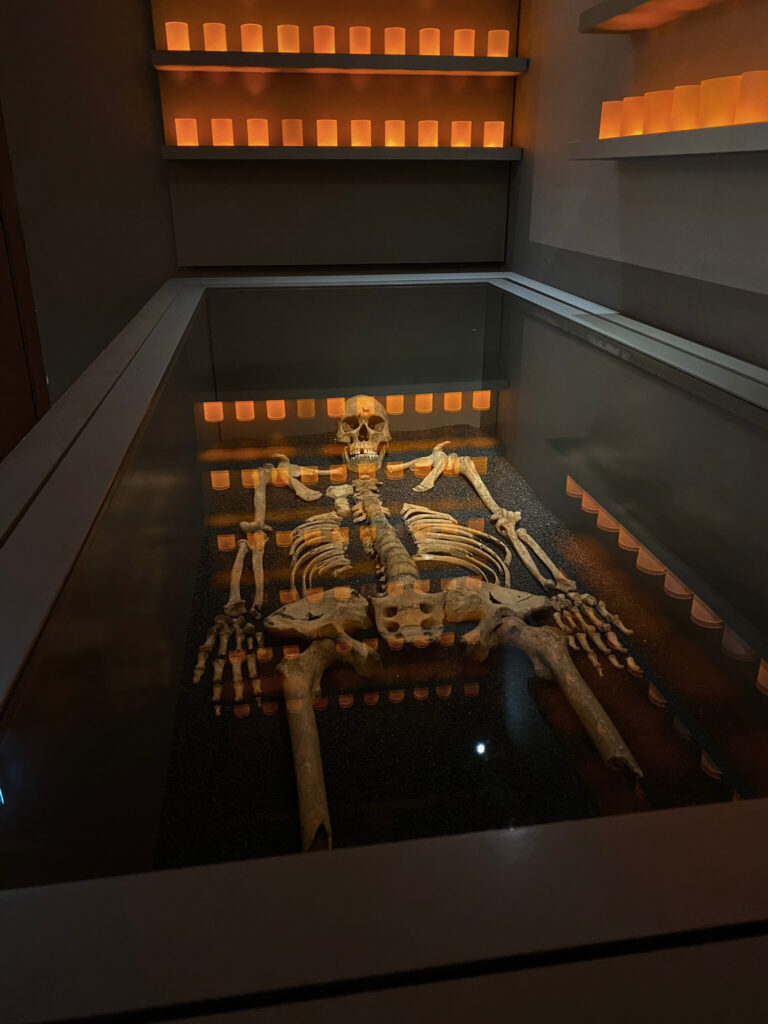
The room is kept dark, softly lit by warm LED candles that line the walls around the skeleton’s display case. There is a definite air of respect for this unknown human who died so long before any of us even existed. I stayed there for a while, just admiring him and said a quiet thank you for letting me come and stare at his bones.
Technically, the skelly belongs to the Museum of London, but they have loaned it to the Charterhouse for exhibit. Considering that was where he was discovered, I think that’s only fair.
In the gift shop outside of the museum, they have cups that say ‘brothers in alms’ which made me simultaneously amused and furious – man, I love a good pun. Note: All proceeds from the gift shop go back into the almshouse and taking care of its residents!

Black Death
I found a book called Black Death, by Stephen Porter, and simply couldn’t resist buying it. Mr Porter was a historian and archivist who studied the Charterhouse for many years. He wrote a book about the place, as well as many articles. His work greatly helped with the opening of the museum I’d just seen.
Black Death, though, is a book about the many epidemics that have plagued (lol) London’s history, including the titular (and arguably most famous) one. It was quite a dense read and took me a while to get through, but I learned a lot and found it very interesting. The Charterhouse does feature in the book several times, what with it being built on plague pits and all. Each mention was like a little wave from a friend.
Charterhouse Life in the 21st Century
I mentioned above that the Charterhouse still houses people to this day. More specifically, they accommodate single people over the age of 60. They must have some kind of financial or social need for help with accommodation, but must also still be able to live independently. (Editor’s Note: if a Brother becomes sick or is reaching the end of their life, don’t worry – they’re not just slung out of the Charterhouse! There is a fantastic infirmary on-site to give them the best care that they require).
The residents are called Brothers, after the Carthusian monks who once resided at the monastery. These days, that term is gender neutral, as they finally started to admit women in 2017, and the almshouse is now mixed sex. Beneficiaries of it have their own private little flats and they’re able to come and go whenever they like. However, they always have meals available in the Great Hall on campus, and there are loads of community activities.
In the UK, there are still many almshouses, but the one at Charterhouse seems so integrated in its local community. It’s lovely!
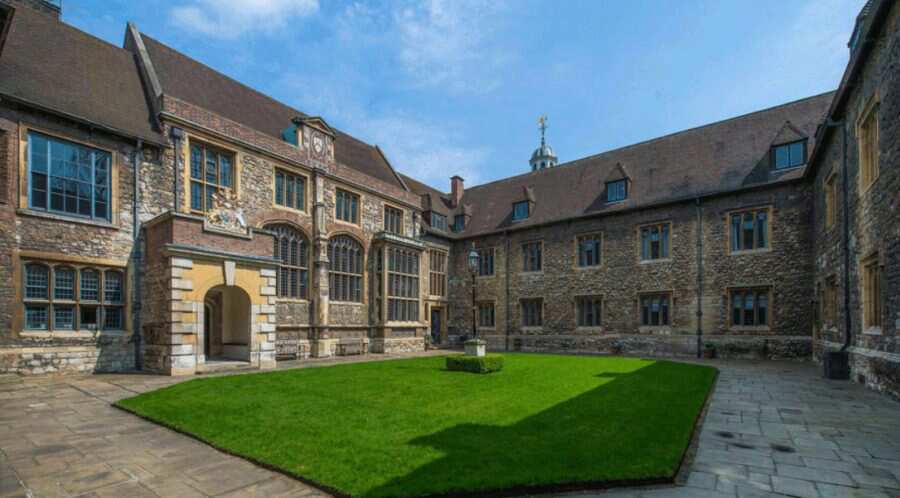
Visiting the Charterhouse
While I wrote this post, I had a real look at the Charterhouse website to learn more about what you can do there. I found a whole list of different tours you can join! These are:
- Charterhouse (the main tour)
- Brothers (an actual resident, or ‘Brother’, will guide you!)
- Garden/House & Garden (summer only)
- Family (special booking required)
- Art & Historic Interiors (special booking required)
- Charterhouse by Candlelight (winter only)
- British Sign Language (special booking required).
It’s amazing that they have so many to choose from! There’s really something for everyone, no matter what your interests are. Family tours include looking for teddy Talbots as you discover Thomas Sutton’s story and the Charterhouse’s history. Perfect for kids, but – full disclosure – I would absolutely love to find the teddies too!
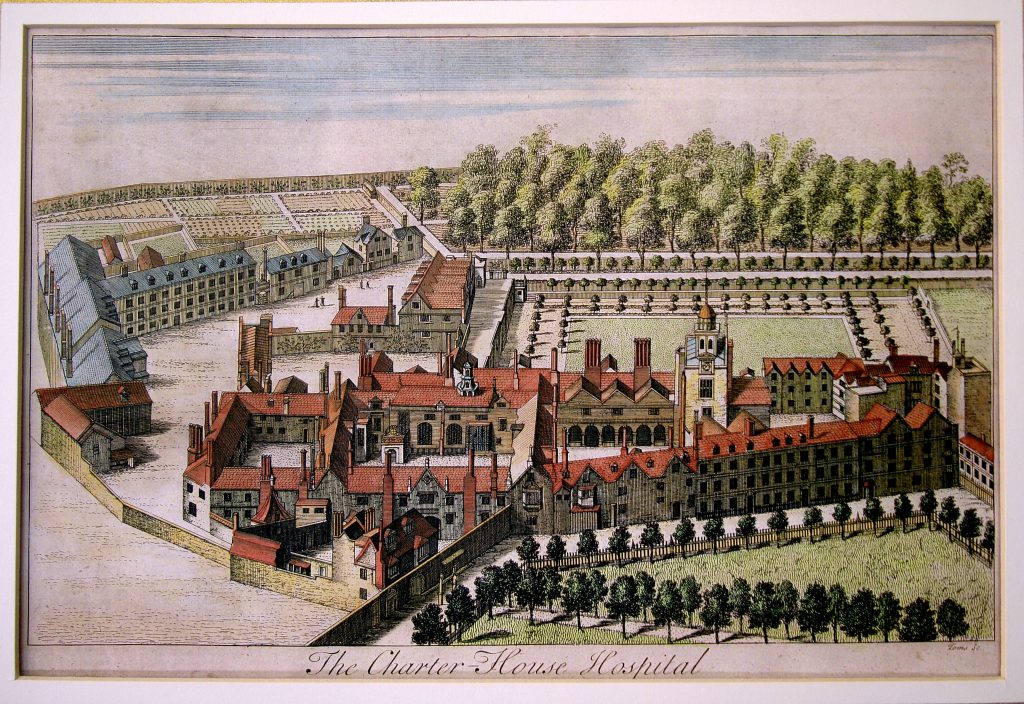
© The Charterhouse
The Charterhouse also holds occasional online lectures that you can access. I’ve bookmarked one from a couple of years ago. In it, author Tracy Borman gives a lecture on one of her books, James I and the English Witch Hunts. Sounds very interesting, and it’ll probably whet my appetite enough to get the book (not a hard feat, to be honest).
Every Friday from 10:00-12:00, there is a community space at the Charterhouse. Hot drinks are served, and anyone can come and have a chat or just chill out quietly. I think that’s a great idea, and speaks to the Charterhouse’s continued connection with the local community.
In the summer, there are often plays on at the Charterhouse. This June, they’ll be doing All’s Well That Ends Well and a bicycle version of The Comedy of Errors by a roaming acting troupe named the HandleBARDS (brilliant, I’ll say it again – I love a good pun, me).
Family Trees
Over the years, lots of visitors have accidentally discovered that they have family ties with the Charterhouse’s history. Now there is a whole page on the website that talks about finding out if you have any of these connections. People interested in genealogy now also have a reason to go to the Charterhouse – they’re really broadening their niches!

Obviously I need to go back to the Charterhouse, as I missed looooads of cool things. The campus actually covers 7 acres! I was on a one-track mission to see the plague skeleton. As usual, my morbid tendencies became my downfall. I’m glad I went because it turned out to be a really interesting and peaceful little place.
You should definitely pay them a visit if you have an interest in history – so many eras appear in just this one place! Even if you just want to see a Real Skeleton, go and show them some love.

